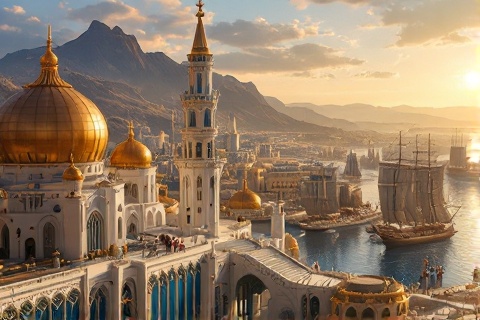
Númenóreans: Legends of the Star Isle
Exploring the Rise and Fall of Tolkien's Greatest Civilization
The Gift of the Valar

The island of Númenor emerged from the depths of the Great Sea
as a divine gift from the Valar to the Edain who
fought alongside the Elves in the War of
Wrath. This magnificent realm, also known as Elenna or
the Land of Gift, rose from the waters in the beginning of the Second
Age as a reward for the unwavering loyalty and valor of the
Three Houses of Men who stood against Morgoth in the First
Age. The Valar shaped this blessed land with their power,
creating a paradise that would serve as home to these noble Men.
In the year 32 of the Second Age, the kingdom of Númenor was officially
established under the rule of Elros Tar-Minyatur, son of
Eärendil and brother of Elrond. Elros became
the first King of Númenor, establishing a dynasty that would endure for
thousands of years. The Valar bestowed upon him and his descendants the wisdom
and strength to govern this magnificent realm, marking the beginning of the most
glorious kingdom of Men in all of Tolkien's legendarium.
Númenor was shaped like a five-pointed star, earning it the elvish name
Elenna-nórë, the Land of the Star. Located in the Great Sea between
Middle-earth and Aman, the island's central feature was
the towering mountain of Meneltarma, rising from its heart. The western regions
enjoyed a milder climate and received ships from Tol Eressëa at the port of
Andúnië, while the eastern shores, anchored by the bustling port of Rómenna,
served as the launching point for voyages to Middle-earth. This strategic
position allowed the Númenóreans to become the greatest mariners of their age.
The Blood of Westernesse
The Númenóreans were descended from the noblest houses of the Edain: the House
of Hador from Dor-lómin, renowned for their golden hair and
great strength; the House of Bëor, known for their wisdom and dark hair; and the
House of Haleth, celebrated for their independence and resilience. These
bloodlines combined to create a people of exceptional qualities, who inherited
the best traits of each house. The Valar blessed these lineages with enhanced
vitality and strength, setting them apart from other Men of Middle-earth.
The physical attributes of the Númenóreans were remarkable, making them stand
out among all races of Men. They were extraordinarily tall, with many of their
kings and nobles reaching seven feet in height. Their most distinctive features
were their bright grey eyes, which seemed to shine with an inner light,
reminiscent of their Elvish allies. The Valar granted them lifespans three times
longer than ordinary men, with the royal line often living beyond 400 years.
Their vigor remained until the end of their days, showing little sign of aging
until their final years.
The choice of Elros to embrace mortality, unlike his brother Elrond who chose
immortality, had profound implications for the Númenórean bloodline. As a
descendant of both Elves and Men, Elros passed on to his heirs a measure of
elvish grace and power. This half-elven heritage manifested in the royal line
through enhanced wisdom, nobility, and longer life spans. The Kings of Númenor
could trace their lineage directly to Elros, and through him to the illustrious
houses of both Elves and Men, including Beren,
Lúthien, Tuor, and Idril.
Masters of the Sea

The Númenóreans developed shipbuilding techniques far surpassing those of any
other mortal realm. Their master craftsmen created vessels of unprecedented size
and durability, capable of withstanding the fiercest storms of the Great Sea.
These ships featured tall masts, multiple decks, and hulls crafted from
hardwoods treated with secret preservative methods. The ships bore distinctive
silver and black sails, and their prows were often adorned with sculptures of
eagles, swans, or other noble creatures.
As their maritime technology advanced, the Númenóreans embarked on increasingly
ambitious voyages across the seas of Arda. They established colonies along the
coasts of Middle-earth, from the northern wastes to the southern reaches of
Harad. Their mariners became legendary for their ability to navigate by the
stars, and they created detailed maps and charts that guided their expanding
maritime empire. These expeditions led to the establishment of permanent havens
such as Pelargir and Umbar, which became vital centers of trade and cultural
exchange.
The great havens of Rómenna and Andúnië served as the maritime hearts of
Númenor. Rómenna, on the eastern coast, was the primary port for journeys to
Middle-earth, featuring extensive dockyards, warehouses, and maritime academies
where the arts of shipbuilding and navigation were taught. Andúnië, nestled in a
natural bay on the western coast, welcomed the ships of the Eldar from Tol
Eressëa and served as the seat of the Lords of Andúnië, who remained faithful to
the old alliance with the Elves until the very end.
The Golden Age

The cultural achievements of Númenor encompassed numerous fields, from
metallurgy to medicine. Their craftsmen developed technologies for working steel
and other metals that would not be matched until the Third Age. The Númenóreans
created intricate mechanical devices, advanced healing techniques, and methods
of food preservation that allowed their ships to undertake longer voyages. Their
scholars compiled vast libraries of knowledge, covering subjects from astronomy
to history.
The relationship between the Númenóreans and the Elves of Tol Eressëa was
particularly fruitful during the kingdom's golden age. Elvish ships regularly
visited the western havens, bringing gifts of knowledge, art, and precious
materials. The Eldar taught the Númenóreans many skills, including the art of
making palantíri, the seeing-stones. This friendship
enriched Númenórean culture with music, poetry, and lore that elevated their
civilization to heights unmatched by any other realm of Men.
The cities of Númenor were marvels of urban planning and architecture.
Armenelos, the capital city, featured the King's House with its silver dome and
the famous Tower of the King. The city of Andúnië boasted magnificent harbors
and elegant mansions, while Rómenna showcased impressive maritime
infrastructure. These urban centers were characterized by white stone buildings,
broad avenues, and public spaces adorned with sculptures and fountains.
The agricultural and architectural achievements of Númenor were equally
impressive. The island's farmers developed advanced irrigation systems and crop
rotation methods that produced abundant harvests. The land was carefully managed
with terraced hillsides and protected forests. Their architects created
structures of unprecedented scale and beauty, including the Temple built during
the reign of Ar-Pharazôn, which, despite its dark purpose, demonstrated their
mastery of construction techniques. The roads of Númenor were expertly
engineered, connecting all parts of the island with paved highways that lasted
for centuries.
Guardians of Middle-earth
In the middle of the Second Age, the Númenóreans provided crucial assistance to
the Elves in their struggle against Sauron. Under the
leadership of Tar-Minastir, they sent a powerful fleet to Gil-galad's aid in SA
1700, helping to drive Sauron from Eriador. This intervention demonstrated both
their military might and their commitment to the alliance with the Elves. Their
forces proved so formidable that Sauron himself retreated from battle upon
seeing their approach.
The establishment of Gondor and Arnor began as
colonial ventures but grew into powerful realms in their own right. The
Númenóreans built great fortresses and cities along the coasts of Middle-earth,
including Pelargir, Umbar, and the tower of Orthanc in Isengard. These
settlements served as bases for further exploration and as centers of Númenórean
culture and power in Middle-earth.
The Númenóreans took on the role of teachers and benefactors to the lesser Men
of Middle-earth. They shared their knowledge of agriculture, metalworking, and
other crafts with the indigenous peoples they encountered. The Men of
Middle-earth looked upon the Númenóreans with awe, calling them Sea-kings and
receiving their guidance in matters of culture and technology. This period
marked the height of Númenórean influence in Middle-earth, though it would later
be tainted by imperialism and exploitation.
The Shadow Falls

As their power grew, the Númenóreans began to resent their mortality, viewing it
as a curse rather than Ilúvatar's gift to Men. This fear of death became
increasingly pronounced, particularly among the later kings. The people began to
build elaborate tombs and became preoccupied with preserving their lives,
leading to a gradual estrangement from the Eldar and the Valar. This growing
discontent would prove fertile ground for Sauron's later manipulations.
Under Sauron's influence, many Númenóreans turned to dark practices and the
worship of Melkor. The construction of the Temple to
Melkor marked a terrible turning point in their history. This massive structure,
built with the wealth and skill of Númenor, became the site of human sacrifices,
particularly targeting the Faithful who maintained their allegiance to Ilúvatar.
The Temple's smoke could be seen from all parts of the island, a symbol of the
kingdom's moral decay.
The persecution of the Faithful, led by the Lords of Andúnië and their
followers, intensified as the kingdom fell further under Sauron's sway. These
loyal Númenóreans faced imprisonment, exile, and death for maintaining their
friendship with the Elves and their worship of Ilúvatar. Many were forced to
flee to Middle-earth or hide their true beliefs, while their traditions and
writings were suppressed or destroyed.
The final act of defiance against the Valar came when Ar-Pharazôn, goaded by
Sauron, broke the Ban that prohibited the Númenóreans from sailing west toward
Aman. This ancient prohibition had been established to protect Men from seeking
immortality in the Undying Lands. The breaking of the
Ban represented the culmination of Númenórean pride and rebellion against the
natural order established by Ilúvatar.
The Downfall

In the year 3319 of the Second Age, Ar-Pharazôn assembled the greatest armada
ever seen in Arda. The fleet consisted of countless ships, their black sails
darkening the skies as they approached the shores of Aman. This unprecedented
military force represented the peak of Númenórean naval power, though it was
destined for destruction. The king's hubris in attempting to seize immortality
by force led directly to the realm's downfall.
The assault on Valinor prompted Ilúvatar himself to intervene, fundamentally
altering the shape of Arda. The Flat World was made Round, and Aman was removed
from the circles of the world, becoming accessible only to the Elves who could
find the Straight Road. This cosmic change marked the end of the direct
intervention of the Valar in the affairs of Men and transformed the very nature
of the world.
The destruction of Númenor came in the form of a massive wave, sent by Ilúvatar
as punishment for their transgression. The wave, described in prophecies as the
Great Wave, completely submerged the island realm. The destruction was total –
cities, monuments, and the entire civilization of Númenor disappeared beneath
the waters of the Great Sea. The site of the former island became a void,
dangerous to all ships that ventured there.
Before the catastrophe, Elendil and his sons, along with other members of the
Faithful, managed to escape the doomed island. They sailed east in nine ships,
carrying with them precious heirlooms, seeds, saplings of significant trees, and
important documents preserving their history and knowledge. These survivors
would go on to establish the Realms in Exile, maintaining some measure of
Númenórean culture and power in Middle-earth.
Legacy of the Star Isle
The surviving Faithful established the kingdoms of Gondor and Arnor in
Middle-earth, preserving many aspects of Númenórean civilization. These Realms
in Exile were founded upon the principles and traditions of their homeland,
featuring distinctive architecture, advanced technology, and sophisticated
systems of governance. The new kingdoms maintained the high culture of Númenor,
though on a lesser scale than their ancestral home.
The preservation of Númenórean knowledge and culture became a primary concern of
the exile communities. The libraries of Minas Tirith contained ancient scrolls
and books saved from Númenor, while the Dúnedain carefully maintained their
traditions and language. The skills of healing, crafting, and lore-keeping were
passed down through generations, ensuring that the wisdom of Númenor was not
entirely lost.
The influence of Númenórean civilization profoundly shaped the history of the
Third Age. The technological and cultural achievements of the Dúnedain provided
the foundation for the kingdoms of Men in Middle-earth. Their bloodlines, though
diminished, continued to produce exceptional leaders and warriors who played
crucial roles in the struggles against evil, culminating in the War of the Ring.
Physical remnants of Númenórean civilization survived into the Third Age and
beyond. The palantíri, though reduced in number, remained powerful tools of
communication and observation. The great fortresses and cities they built, such
as Minas Tirith and Orthanc, stood as testimonies to their architectural
prowess. Their language, customs, and artifacts continued to influence the
cultures of Middle-earth, serving as reminders of the greatest kingdom of Men
that ever existed.
